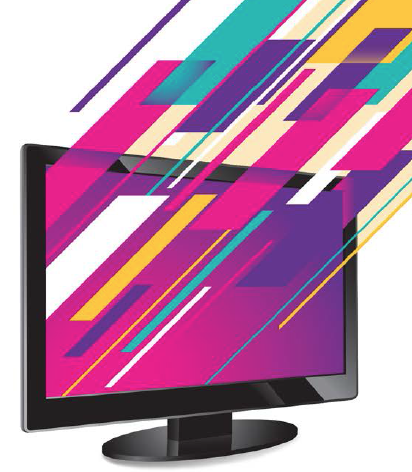 Earlier this year, eMarketer predicted that digital ad spending across all industries would surpass TV for the first time in 2017. Overall, TV ad spending will total $72.01 billion, or 35.8% of total media ad spending; digital ad spending in 2017 will equal $77.37 billion, or 38.4% of total ad spending.
Earlier this year, eMarketer predicted that digital ad spending across all industries would surpass TV for the first time in 2017. Overall, TV ad spending will total $72.01 billion, or 35.8% of total media ad spending; digital ad spending in 2017 will equal $77.37 billion, or 38.4% of total ad spending.
But these rising digital figures do not pertain to the life-sciences industry. Although there are many more channels for pharma to use to reach a targeted audience, and ad dollars for digital in the industry are growing slightly, TV still holds too much value for reaching broad audiences, especially when combined with an integrated approach that incorporates the many other ways to reach health consumers.
“Prescription drug advertising on TV isn’t going away," says Erin Fitzgerald, VP of marketing at AccentHealth. “In fact, it’s steadily increasing and exceeded $3.5 billion last year."
TV, which has always offered the ability to define targets and tailor messages, is largely used to get the attention of a broader audience, which is then followed up through the right channel for the right consumer.
According to our experts, mass marketing has always been a misnomer. The term conveys the idea that a blanket positioning and messaging set is put forward regardless of customer segment. In reality, these campaigns have always had a target audience in mind, be it based on broad categories such as gender and age, or a more specific set of demographics, says Ankil Patel, partner, director of client services at Calcium.
“The advent of thousands of television channels, and millions of websites and YouTube channels, pushes mass marketing toward a hyperamplified and simultaneously microrefined application of the same principles that were used to sell aspirin in the 1940s," Mr. Patel says.
He continues: “In practice, the world has gotten immensely more complicated. Instead of buying a particular prime time slot on NBC, the marketer must construct a campaign architecture that is built on an assessment of myriad channels and shifting/unknown viewership. And, as many of these sites waver in and out of use and influence, highly dynamic models to calculate impact and potential ROI must be developed."
According to Sharon DeBacco, VP, product promotion and communications, at Ironwood Pharmaceuticals, the term “mass" is no longer accurate in today’s target-enabled environment.
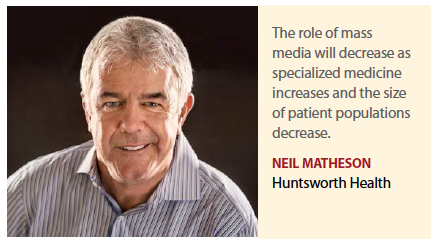 “The masses have long since dispersed and fractionated, and can no longer be reached in one fell swoop as when 18-20+ Nielsen ratings and network domination were the norm," she says. “Now, with a 1-2 rating considered good, and a seemingly limitless supply of cable options, we have to segment and activate very specific, niche-like audiences whose interests align with our key segments, and re-aggregate them to achieve a mass effort. This is actually a step toward mass personalization."
“The masses have long since dispersed and fractionated, and can no longer be reached in one fell swoop as when 18-20+ Nielsen ratings and network domination were the norm," she says. “Now, with a 1-2 rating considered good, and a seemingly limitless supply of cable options, we have to segment and activate very specific, niche-like audiences whose interests align with our key segments, and re-aggregate them to achieve a mass effort. This is actually a step toward mass personalization."
Despite this fragmentation, prescription brands with sizeable patient pools still need to get the broader condition and brand messaging out to the appropriate set of mini-masses to ignite the process of consideration, and nothing achieves scale and builds awareness better than TV, even today, Ms. DeBacco says. TV provides the essential upper funnel broad messaging that enables the lower-funnel targeted channels to work harder.
“And with this as a backdrop, we can now add a new layer of targeting onto TV aimed at the household level for segments that represent a highly concentrated opportunity," she says. “Going well beyond yesterday’s targeting by geography, channel, network and program mix, we now can deliver specific messaging based on what we know about the household, such as purchase behavior and media consumption habits."
In many ways, Ms. DeBacco says, the fragmentation in TV and the increasing opportunities to hyper target in digital has pulled TV and digital closer together, working in a much more integrated way. This helps marketers to think more broadly about how to balance mass reach with targeting across channels.
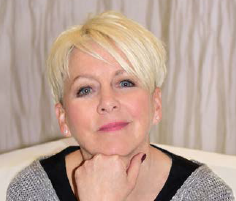 “Our ability to
“Our ability to 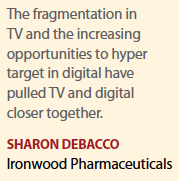 hyper target consumers on an individual level, using actual, de-identified, HIPAA-compliant prescription data, and to reach individuals after they have visited relevant content, searched for a competitive brand, visited a brand’s website, and/or exhibited behaviors of key patient segments continues to expand," she says. “But despite the innovations in targeted media and how rapidly they are catching up to TV, mass media still represents the lion’s share of ad spending, with traditional media such as TV retaining the lead."
hyper target consumers on an individual level, using actual, de-identified, HIPAA-compliant prescription data, and to reach individuals after they have visited relevant content, searched for a competitive brand, visited a brand’s website, and/or exhibited behaviors of key patient segments continues to expand," she says. “But despite the innovations in targeted media and how rapidly they are catching up to TV, mass media still represents the lion’s share of ad spending, with traditional media such as TV retaining the lead."
TV works particularly well for reaching patients who have not yet been diagnosed with a condition, says Neil Matheson, global CEO, of Huntsworth Health.
“Broadcast media is an appropriate way to reach consumers who may not yet identify their symptoms with a medical condition or who may not be aware of the availability of a specific treatment for a condition that they are living with," he says. “Great examples are the campaigns that enabled consumers to identify the symptoms of depression — the ‘Do You Feel Blue’ campaign — and the campaign to educate consumers that overactive bladder is not a consequence of aging and they should seek treatment — the ‘Gotta Go’ campaign."
But in the era of specialized medicine, the role of mass media will decrease as specialized medicine increases and patient populations decrease in size. Smaller patient populations can be accessed more effectively on a personal level, and these patients are often also associated with patient groups — from patient advocacy groups as well as informal online patient groups — and can be accessed through these channels as well, Mr. Matheson says.
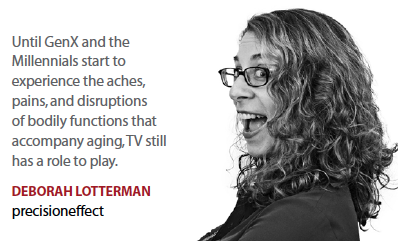 Mass advertising has always been about broad reach and maximum impressions, but it is evolving in response to today’s market, says Dave Sheehan, chief marketing officer, ContextMedia:Health.
Mass advertising has always been about broad reach and maximum impressions, but it is evolving in response to today’s market, says Dave Sheehan, chief marketing officer, ContextMedia:Health.
“Today’s mass advertising includes channels that can reach audiences at scale with far more accuracy against key targets than in the past," he says. “By leveraging new digital technologies, marketers can reap the advantages of advertising to the masses such as scale, brand recognition, low risk and cost, while minimizing the challenges of targeting and convincingly tracking a return on investment."
Until GenX and the Millennials start to experience the aches, pains, and disruptions of bodily functions that accompany aging, TV will have a role to play, says Deborah Lotterman, chief creative officer, precisioneffect.
“Given that an abundance of prescription drugs are indicated for patients over the age of 50, TV can still be very effective," she says. “We’ve seen this in our work with Cologuard, a non-invasive sDNA screening test for colon cancer."
Since the agency launched a national TV campaign with a targeted media buy, sales of Cologuard have increased by 24% and the number of physicians ordering the test has doubled.
That’s not to imply that patients over the age of 50 do not spend time online; they do and they need to be targeted there as well, she says. Consumers are watching TV and using their phones and tablets at the same time, and marketers must keep in mind the overlay of cross channel viewing and multiple screens.
“Applying more incisive segmentation, targeting technologies, and thoughtful content marketing means we can use budgets far more effectively to identify, zero in on, and convert the most valuable prospects, be they physicians or patients," Ms. Lotterman says.
Changes in Creative for Today’s Mass Marketing
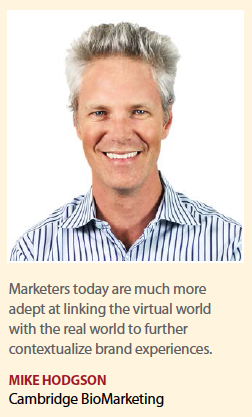 Creative strategies have evolved from a single brand creative strategy into a set of multiple layers of increasingly targeted messaging, that connect “mass" — upper funnel broad creative — to lower funnel, “highly targeted" creative. This balance of channels and continuum to more targeted messaging facilitates the patients’ journey from the initial spark of interest to full brand consideration and definitive action.
Creative strategies have evolved from a single brand creative strategy into a set of multiple layers of increasingly targeted messaging, that connect “mass" — upper funnel broad creative — to lower funnel, “highly targeted" creative. This balance of channels and continuum to more targeted messaging facilitates the patients’ journey from the initial spark of interest to full brand consideration and definitive action.
According to Ms. DeBacco from Ironwood, mass marketing serves an essential role as the upper funnel “inspirational" channel to start the conversation between a brand and its audience, and subsequent layers of messaging drive increasing relevance, engagement, and movement along the pathway, leveraging all the tools available, including dynamic messaging, retargeting, sequential messaging and customization. The totality of the brand’s content, relevancy by channel, and overall channel delivery can create a meaningful, informed behavior change that leads to a solid new start on the brand.
“We are also seeing a shift in the creative development process," she says. “What used to be sequential and siloed — creative development in isolation by the creative agency, followed by the media agency deciding where to place the content — is now a collaborative process that jointly determines which tactics work best for the brand and which creative is best suited to those tactics."
Even as long as television has been used for DTC, it still isn’t always leveraged to its best asset, Mr. Matheson says.
“Television is an amazing medium for emotional engagement through story telling and I don’t think we have taken advantage of the opportunity to utilize the medium in this regard," he says. “The creative approach to TV is still very much based on the traditional data-driven features and benefits approach the industry has taken with healthcare providers in the past."
Consumers want something more exciting and need to be drawn in with emotionally engaging content.
“Too many pharma ads are dull and boring," Mr. Matheson says. “Too many people use medical/legal restrictions as the excuse for mediocre creative and lack of emotional engagement but I don’t buy it. There is plenty of room for amazing creativity and emotionally engaging story telling if agencies have the courage and talent to generate the creative, support their client through medical/legal review, and push their clients to be bold."
Creative for mass-market ads must appeal to a broad swath of potential patients, and to some extent, the “boring" ads are still effective. The typical DTC formula includes representative patient types who carry on a story arc from disease/problem to brand/solution. Many ads boil down to “shiny, happy people" doing a variety of photogenic activities. Think of the typical beach walk, with dog, of course.
“These pharma creative clichés continue to have currency because, on some level they have been proven to work: they engage broad patient audiences on the basis of a sunny emotionalism, the sense that, even when a serious disease is present, the story can have a happy ending," Mr. Patel of Calcium says. “The success of this formula guarantees that this type of creative will continue to dominate DTC."
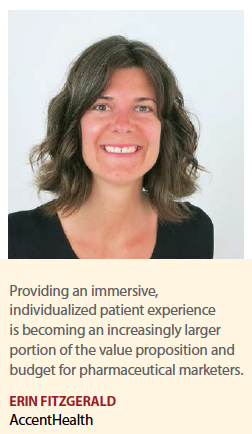 However, Mr. Patel has observed a change occurring in mass-market pharma creative. Some brands are avoiding the clichés of slice-of-life advertising in favor of approaches that are more conceptual — and differentiated.
However, Mr. Patel has observed a change occurring in mass-market pharma creative. Some brands are avoiding the clichés of slice-of-life advertising in favor of approaches that are more conceptual — and differentiated.
“The Pradaxa ‘Goldfish’ TV campaign is a good example," he says. “The campaign uses swimming goldfish as a striking visual metaphor for blood flow. No people — and no beaches — are present."
The metaphor has an obvious conceptual appeal, but it delivers a surprisingly emotional impact as well. Mr. Patel hopes this campaign points the way to a more thoughtful — and less tired and predictable — DTC creative.
Bringing the techniques of virtual reality and real-time interaction to creative could be a wave of the future, says Mike Hodgson, chief creative officer, Cambridge BioMarketing.
As marketers become much more adept at linking the virtual world together with the real world to further contextualize brand experiences — think Pokémon Go — the commercialization opportunities are endless. Facilitating health dialogues that cross over from the virtual to the physical world in homes and in physician’s offices is key to brand accessibility, Mr. Hodgson says.
“Consumers want to integrate their favorite brands into their lives, either having a conversation with the brand or using it as a jumping-off point for conversations with friends," he says. “A great example is the Taco Bell lens in SnapChat that allows consumers to turn their heads into giant taco shells. Similarly, we are working closely with clients to help patients and families integrate health experiences into their lives, and then communicate them with the broader community."
The biggest change in mass-marketing strategy today is that messaging and creative are only a starting point. The most important work happens in the follow through.
“Technology has given us the ability to not only change behavior, but also measure how it changes," ContextMedia:Health’s Mr. Sheehan says. “Today, digital solutions give us the tools to deliver the impactful creative strategies at scale, and draw actionable insights from them to better serve the patient and consumer."
Providing an immersive, individualized patient experience is becoming an increasingly larger portion of the value proposition and budget for pharmaceutical marketers, Ms. Fitzgerald of AccentHealth says. To deliver this experience, brands must educate and engage patients at key moments along the journey when they are hungry for information about their condition or treatment. This includes at the point of care, which is growing faster than DTC overall at 15% to 20% per year, as well as pre-visit symptom and post-visit treatment research.
“Furthermore, in light of today’s culture of convenience and access, marketers must ground the experience in digital and redirect some resources toward the new, compliant technologies such as geo-fencing, smart Wi-Fi, telehealth and, before long, virtual reality," she says.
Consumer Behavior Driving Trends
As television continues to get the larger share of the ad budget, brands must also diversify and use the remaining channels wisely, as consumers are using more and more digital avenues in their daily lives. Emerging trends in consumer behavior are creating a consumer-driven model that is laden with data along each touch point of the patient journey.
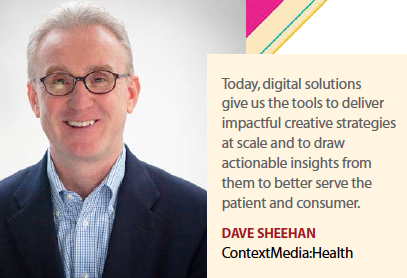 “Consumers want more focused experiences, dictated by their own terms," Ms. Lotterman says. “In a bit of a virtuous circle, their focused online activities create tremendous data exhaust. This offers the potential for brands to anticipate and fulfill consumer needs better than ever."
“Consumers want more focused experiences, dictated by their own terms," Ms. Lotterman says. “In a bit of a virtuous circle, their focused online activities create tremendous data exhaust. This offers the potential for brands to anticipate and fulfill consumer needs better than ever."
“As marketers, this means if we can continue to deliver relevant information about products or services to patients when and where they seek it, we can influence behavior unlike ever before," Mr. Sheehan says.
First, the industry must learn how perceptions are the basis of attitudes and that attitudes drive behavior, Mr. Matheson says. The industry has a lot to learn about value drivers and how consumers apply their own perspective to determining value. In the consumer world, there are many value drivers that the pharmaceutical industry has never been exposed to and these drivers will create challenges for industry that is not used to listening to, and truly understanding, the real customer.
“To understand perceptions/attitudes we need to obtain deep insights from the consumers we want to target and connect those insights to brand value," he says. “Only then will we be able to impact consumer behavior."
Finding the right balance of messaging across channels and ensuring that the brand’s content is relevant to how customers use each channel are essential.
Content can’t be created with one channel in mind, but should be tailored on a channel-by-channel basis, and delivered to everywhere it is relevant to large clusters of the target segments, so the totality of brand engagement inspires action, Ms. DeBacco says.
At the same time, the industry should stay current on shifts in channel usage. According to Ms. DeBacco, digital use is projected to reach six hours per day by 2017, compared with three and a half hours for TV among consumers age 18 and older.
Mobile use exceeds desktop, and multitasking distracts the audience and reduces attention span — consider that 82% of consumers use their mobile device while watching TV, 69% text while watching TV, 55% watch video while watching TV.
“While these trends clearly influence media selection and channel mix, arguably their role in informing creative and messaging is critical," she says.
“Messaging absent consideration for the context of user consumption is unduly compromised out of the gate."
“Many of the relevant and emerging trends in consumer behavior relate to how we need to adapt as marketers to better connect with consumers," Mr. Patel says. For instance, consumer attention continues to be fractionalized among various mediums: tablets, readers, desktops, TV, and mobile.
“This divided consumption of information comes with the prerequisite demand from consumers to make sure their experience feels unified by ensuring continuity of information across platforms," he says. “For today’s consumer it is important that we make every act of engagement complementary to the one that came before it in our overall attempt to tell our brand narrative."
Consumers want to be able to pick up where they left off, regardless of which device they are using to consume content. This continuity of content does not mean to imply that each medium needs to provide the exact same experience, but each medium should deliver an experience in line with that medium’s strengths: mobile for “quick bites" of information, tablet for additional “story lines’ for the brand, and desktop for when a consumer is willing to make a deeper investment of time with a brand, Mr. Patel says.
Even scientific information provided by experts in the field is being disseminated through digital media channels these days, says Mahesh Naithani, CEO of Medmeme. Five to 10 years ago companies used traditional print and education mechanisms to reach physicians and patients through brochures and certainly television and radio spots.
“Today the use of digital, technology, and social media is emerging in the healthcare space, as younger consumers have grown up with social media and they want to be able to receive this information through a social media environment," he says.
This allows pharma companies to be much more focused on getting out the message to the right consumers versus blanketing the overall community. Mr. Naithani believes as this trend grows, more and more money will flow out of television and into the digital space.
“This is going to have a large impact on what happens," Mr. Naithani says. As digital gains more ground, the approach will become more screen agnostic. “It’s not about television versus digital but what are the screens that people are using." (PV)


















